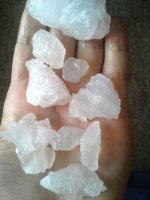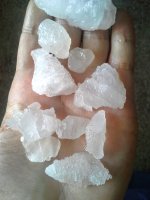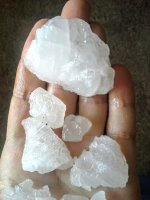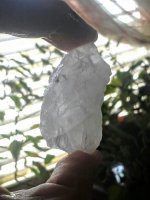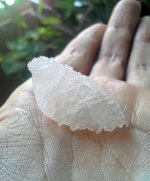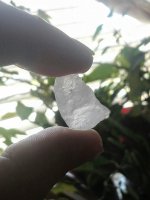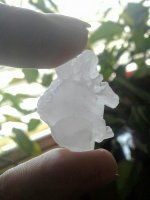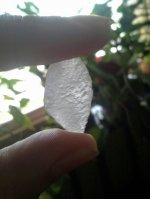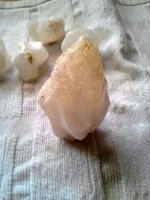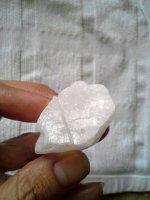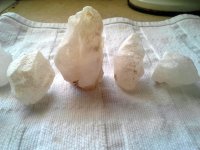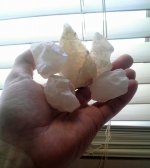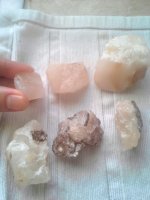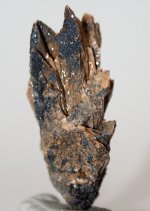Navigation
Install the app
How to install the app on iOS
Follow along with the video below to see how to install our site as a web app on your home screen.
Note: This feature may not be available in some browsers.
More options
You are using an out of date browser. It may not display this or other websites correctly.
You should upgrade or use an alternative browser.
You should upgrade or use an alternative browser.
Curious if this is Elestial angel calcite crytals?
- Thread starter Steve1236
- Start date
IAMZIM
Bronze Member
- Apr 23, 2011
- 1,567
- 2,160
- Detector(s) used
- ace 250/garret pinpointer, garret AT Gold
- Primary Interest:
- All Treasure Hunting
Interesting, try some vinegar on it, (a drop) if it bubbles it could be calcite. If not, try a hardness test to see if it could be quartz, (what I think it might be) or it could be clear flourite. Was going to say possibly selenite, but when I zoom on the pics, I'm not so sure. Let us know your "test" results!
Upvote
0
IAMZIM
Bronze Member
- Apr 23, 2011
- 1,567
- 2,160
- Detector(s) used
- ace 250/garret pinpointer, garret AT Gold
- Primary Interest:
- All Treasure Hunting
Cool! Here are some types of calcite:

Agaric Mineral - Crumbly white Calcite found on cavern floors near stalagmites and stalactites. 
Anthraconite - Dark gray to black variety of Calcite with a bitumen coating or inclusions. 
Aphrite - Lamellar variety of Calcite. 
Cobaltocalcite - Cobaltocalcite refers to an intermediary mineral between Calcite and Sphaerocobaltite in a solid solution series. It is most often perceived as a cobalt-rich variety of Calcite with a rich pink color. (Cobaltocalcite may also be mistakenly used as a synonym for Sphaerocobaltite). 
Corn Spar - Calcite aggregate resembling a corn cob with distinct kernels. 
Dogtooth Calcite - Calcite in groupings of thick and pointy scalenohedral crystals. 
Flowstone - Calcite formed by mineral-rich water that deposits the dissolved mineral on the walls of caverns and cliffs, forming a smooth and humpy growth. 
Hog-toothed Spar - Calcite with long, sharp, incisor-like crystals. 
Iceland Spar - Large, transparent, colorless to lightly colored, rhombohedral variety of Calcite. Double refraction is especially noted in Iceland Spar crystals. (Iceland Spar may occasionally also be used as a synonym for Calcite.) 
Manganocalcite - Calcite with manganese impurities resulting in a pink color. 
Nail Head Spar - Calcite crystals resembling a nail, with a triangular cross section head atop a long and thin prismaticcrystal. May also refer to two perpendicular scalenohedral crystals intersecting in the shape of a "T". 
Onyx Marble - Travertine or Tufa in the mineral form of Aragonite or Calcite that exhibits color banding. 
Optical Calcite - Synonym of Iceland Spar. 
Rice Grain Spar - Calcite grouping of small, white scalenohedral crystals appearing as grains of rice. 
Salmon Calcite - Orange-red, "salmon" colored variety of Calcite that is usually opaque. 
Sand Calcite - Calcite that trapped particles of sand in its interior when it formed 
Satin Spar - Fibrous variety of Gypsum. May occasionally also describe a fibrous form of Calcite or Aragonite. 
Stalactite - Icicle-like mineral formation (usually Calcite) found on the roof of caverns, created when mineral-rich water drips down and the dissolved mineral accumulates into the icicle-like formation. 
Stalagmite - Tall, domed mineral formation (usually Calcite) on the bottom of caverns that from from the build-up of mineral-rich water that deposits the dissolved mineral on the cavern floor. 
Travertine - Mounds of calcium carbonate formed from hot springs that contain calcium-rich water that bubbles up to the earth and cools down, and its capability to hold calcium is reduced. The water eliminates the calcium, and the calcium forms a growing mound of calcium carbonate, which is porous. Travertine is usually Aragonite, although it may also be Calcite. 
Tufa - Aragonite (or Calcite) formed from precipitating water that traps in organic matter, such as leaves, twigs, and moss. Also calcareous mounds formed from deposition of hot springs that trap in organic matter. |
Upvote
0
So now you know it dissolves in acid. 
Other rocks dissolve in acid too. Calcite has an interesting characteristic, it is birefringent. That means it's doubly refractive and will show two of any object seen through the calcite.
Try this test. Draw a pencil line on a white piece of paper and lay your clearest piece of rock right on the pencil line. If the rock is calcite you will see two of the pencil lines through the rock.
Here's another test. Calcite is really soft - a 3 on Mohs scale of hardness. Try scratching the rock with a piece of copper - an old all copper penny or a thick piece of copper wire should do the trick. Do not use a modern zinc penny because zinc is actually softer than calcite. Try to scratch the rock with the copper. If the rock scratches it's possibly calcite, if it doesn't scratch but the copper leave a streak it's unlikely to be calcite.
If your rock passes all those tests there is a good chance it's calcite. If it fails some of the tests we know a lot more about what it might be as well as what it isn't. Isn't science fun?
Calcite is just a form of calcium carbonate. There's a lot of different forms of calcium carbonate including limestone, caliche and cement, the stuff is everywhere. I don't see any particular crystal form in your rock so even if it is Calcite it doesn't necessarily have a natural origin. Try to describe what type of rock or environment your rock was found in and it might be easier to tell if it's a natural stone.

Other rocks dissolve in acid too. Calcite has an interesting characteristic, it is birefringent. That means it's doubly refractive and will show two of any object seen through the calcite.
Try this test. Draw a pencil line on a white piece of paper and lay your clearest piece of rock right on the pencil line. If the rock is calcite you will see two of the pencil lines through the rock.
Here's another test. Calcite is really soft - a 3 on Mohs scale of hardness. Try scratching the rock with a piece of copper - an old all copper penny or a thick piece of copper wire should do the trick. Do not use a modern zinc penny because zinc is actually softer than calcite. Try to scratch the rock with the copper. If the rock scratches it's possibly calcite, if it doesn't scratch but the copper leave a streak it's unlikely to be calcite.
If your rock passes all those tests there is a good chance it's calcite. If it fails some of the tests we know a lot more about what it might be as well as what it isn't. Isn't science fun?
Calcite is just a form of calcium carbonate. There's a lot of different forms of calcium carbonate including limestone, caliche and cement, the stuff is everywhere. I don't see any particular crystal form in your rock so even if it is Calcite it doesn't necessarily have a natural origin. Try to describe what type of rock or environment your rock was found in and it might be easier to tell if it's a natural stone.
Upvote
0
- Thread starter
- #8
View attachment 1615639View attachment 1615641View attachment 1615642
These are some images of Elestial angel calcite crytal I got off Google images, I'm thinking about getting rid of them and I want to make sure I label them right. I have no idea on the other one's I posted either, any help would be much appreciated.
These are some images of Elestial angel calcite crytal I got off Google images, I'm thinking about getting rid of them and I want to make sure I label them right. I have no idea on the other one's I posted either, any help would be much appreciated.
Last edited:
Upvote
0
View attachment 1615639View attachment 1615641View attachment 1615642
These are some images of Elestial angel calcite crytal I got off Google images, I'm thinking about getting rid of them and I want to make sure I label them right. I have no idea on the other one's I posted either, any help would be much appreciated.
Your pictures don't show up Steve. Google will not allow other websites to link to their pictures.
Someone may be selling "Elestial angel calcite crytal" but the terminology is entirely made up. Elestial was only recently applied to quartz crystals as a marketing gimmick. There is no definition for the word Elestial in English or in mineral terminology or in any other language for that matter.
Now you would like to apply the term Elestial to another mineral than quartz for the sake of a sale. This makes me sad. People here are eager to help you understand minerals, rocks and gems and I for one could care less if you sell the minerals you find but somehow I feel you are looking for validation of your made up terminology as much as you are seeking knowledge about the rocks you found. I hope I'm wrong about that but you've got to admit it kinda looks that way.
The link I provided seems to try to pretend the calcite deposits you have are "a newly discovered rare gem named after the meteorite Moldavite". That's more than a little puzzling because neither meteorites nor Moldavite have anything to do with calcite. Moldavite is only found in one small area of Europe. Moldavite looks nothing like calcite. There is no such thing as a meteorite Moldavite. Moldavite is one of the rarest stones on earth, Calcite is one of the most common.
Although calcite is a common mineral - particularly in the quantities and quality you are showing here I also pointed out that one of the most common forms is concrete, a man made conglomerate stone. In point of fact anyone can make their own calcite for the price of a bottle of vinegar and a little study time. $198 for a piece of calcite with some wire wrapped around it might be just the right price for a few ignorant people but I'll bet with just a little education the "Elestial" and the "angel" will be seen as 98% of the value of this common mineral whether man made or natural.
Upvote
0
- Thread starter
- #10
So look pal I grabbed this stuff at my fire agate spot, it's laying everywhere so I grabbed some samples, I have some still attached to ryholite, I have no idea what you are implying about me, I barely know **** about rocks but I'm trying to learn. I was bored earlier and I decided to google images of calcite crytals, elestial angel calcite crytals showed up looking the most like what I found so before I put it on ebay I wanted to get some professional opinions, not a lecture from a jerk 

Upvote
0
So look pal I grabbed this stuff at my fire agate spot, it's laying everywhere so I grabbed some samples, I have some still attached to ryholite, I have no idea what you are implying about me, I barely know **** about rocks but I'm trying to learn. I was bored earlier and I decided to google images of calcite crytals, elestial angel calcite crytals showed up looking the most like what I found so before I put it on ebay I wanted to get some professional opinions, not a lecture from a jerk
Sorry if I offended you Steve, it certainly wasn't my intent. You asked for an opinion and I guess you can call a professional opinion a "lecture" if you want but the "jerk" part is uncalled for. Sometimes the facts may be uncomfortable but they really don't warrant personal attacks do they? Learning shouldn't be painful, why not relax and soak up what knowledge you can instead of reading things into my response?
Last edited:
Upvote
0
- Thread starter
- #12
If I got it wrong I apologize but two parts of your message I took to be offensive, especially implying I'm looking for validation on something I knew was a made up name, I actually didn't, I honestly didnt think this stuff was worth anything until google got ahold of me lol, you could of said what you said without implying. Also the make it yourself calcite I felt was another imply about my character, I dont sell to people on here also, never have...
Upvote
0
If I got it wrong I apologize but two parts of your message I took to be offensive, especially implying I'm looking for validation on something I knew was a made up name...
I'll accept your apology Steve, misunderstandings happen. The internet doesn't convey emotion well, I've found it best to just rely on the words written rather than look for alternative motives.
It seemed from the words you wrote that you were looking for validation.
These are some images of Elestial angel calcite crytal I got off Google images, I'm thinking about getting rid of them and I want to make sure I label them right. I have no idea on the other one's I posted either, any help would be much appreciated.
I took that to mean your concern was for the proper terminology (label) for the rocks you had found. My response was intended to inform you the terminology you were using had no basis in mineralogy or common language. In fact it is strictly a marketing term.
My point about making your own calcite crystals was to show how common calcite is, and easy to obtain, in our day to day world. You said you had found the rocks in a volcanic field you were investigating, I have no reason to doubt that. I've found many different minerals, including calcite, in volcanic deposits.
Are we all good now?
Last edited:
Upvote
0
IAMZIM
Bronze Member
- Apr 23, 2011
- 1,567
- 2,160
- Detector(s) used
- ace 250/garret pinpointer, garret AT Gold
- Primary Interest:
- All Treasure Hunting
I personally did not feel that he had any kind of bad motive here, seems like you are kinda being a little harsh on him......Your pictures don't show up Steve. Google will not allow other websites to link to their pictures.
Someone may be selling "Elestial angel calcite crytal" but the terminology is entirely made up. Elestial was only recently applied to quartz crystals as a marketing gimmick. There is no definition for the word Elestial in English or in mineral terminology or in any other language for that matter.
Now you would like to apply the term Elestial to another mineral than quartz for the sake of a sale. This makes me sad. People here are eager to help you understand minerals, rocks and gems and I for one could care less if you sell the minerals you find but somehow I feel you are looking for validation of your made up terminology as much as you are seeking knowledge about the rocks you found. I hope I'm wrong about that but you've got to admit it kinda looks that way.
The link I provided seems to try to pretend the calcite deposits you have are "a newly discovered rare gem named after the meteorite Moldavite". That's more than a little puzzling because neither meteorites nor Moldavite have anything to do with calcite. Moldavite is only found in one small area of Europe. Moldavite looks nothing like calcite. There is no such thing as a meteorite Moldavite. Moldavite is one of the rarest stones on earth, Calcite is one of the most common.
Although calcite is a common mineral - particularly in the quantities and quality you are showing here I also pointed out that one of the most common forms is concrete, a man made conglomerate stone. In point of fact anyone can make their own calcite for the price of a bottle of vinegar and a little study time. $198 for a piece of calcite with some wire wrapped around it might be just the right price for a few ignorant people but I'll bet with just a little education the "Elestial" and the "angel" will be seen as 98% of the value of this common mineral whether man made or natural.
Upvote
0
- Thread starter
- #19
Hey iamzim it was the "my made up terminology" is what pissed me off, I didn't make it up smh! I was googling up images trying to figure out what this is and I came across what I now know is a con job, if he had simply looked at my posts he'd know I know nothing about rocks and could of just said all what he said without the "my made up terminology" comment! If you can't see that we'll just have to agree to disagree. Plus the imply of me basically trying to rip people off on here but I don't even sell on here, if my memory serves me right you wanted to buy some of my fire agates but did I ever message you about it, nope sure didn't....perceptions vary, I lost years of my life to basically being associated with old friend's of mine who did do wrong but I did nothing and still paid for others sins so yes I take implying or accusations seriously and not kindly.
Last edited:
Upvote
0
DDancer
Bronze Member
- Mar 25, 2014
- 2,339
- 2,003
- Detector(s) used
- Current Equinox 600
Past Whites DFX Garret GTI 2500 and others
Prospecting Minelab GPZ 7000
Past SD 2100 GP 3000 (retired)
- Primary Interest:
- All Treasure Hunting
From what I'm seeing in the first set of pictures I'd call rice spar, Iceland spar and biroidial calcite just for structure and clarity. In your next two batches I suspect you have domolite calcite, especially in the last set of pictures~ the pink hue is indicative of domolite, magnesium, in the calcite.
Have you tried a sw blacklight on it yet? If you do post some pic's. I'd like to see how they flourese. Might be a selling point if you intend to sell.
Have you tried a sw blacklight on it yet? If you do post some pic's. I'd like to see how they flourese. Might be a selling point if you intend to sell.
Upvote
0
Top Member Reactions
-
 3475
3475 -
 1973
1973 -
 1908
1908 -
 1157
1157 -
 1091
1091 -
 1009
1009 -
 889
889 -
 863
863 -
 860
860 -
 793
793 -
 756
756 -
 676
676 -
 659
659 -
 567
567 -
 508
508 -
 453
453 -
 447
447 -
 410
410 -
 400
400 -
E
398
Users who are viewing this thread
Total: 2 (members: 0, guests: 2)
